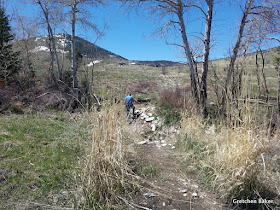
Ward Charcoal Ovens State Historic Park in White Pine County is a pretty cool place to visit. Located east of Ely, Nevada, the charcoal ovens were built when silver mining was big in the area in the nearby Ward Mining District. They operated from 1876 to 1879.
Nearby pinyon pines and juniper trees were cut and put into the ovens. Then the ovens were heated and the wood turned into charcoal, which has a 96% carbon content. The charcoal was desired by the mines because it burned longer and hotter than wood.
I visited Ward Charcoal Ovens many years ago, but didn't have a return visit for many years, until the fall of 2017, before the Women in the Mountains Bicycle Clinic.

On this visit, I wanted to check out some of the trails in the park. They have a nice trail network.
There are some historic features that aren't preserved as well as the charcoal ovens.
Here's a view of the ovens from a higher vista on the trail.
I stayed in the campground, mainly so I could go take photos of the charcoal ovens at night. It was a fun photoshoot.
I snapped a photo of the ovens during the race.
And then after the race, we went over to take a more relaxed look at them. Dogs are allowed on leash.

We went into the first charcoal oven.

It's so big! They could make a lot of charcoal in each oven, which was good, because sometimes it took 30 days of heating to make the charcoal. Then they had to let it cool, and on a calm day open the door. If it was too windy, they risked having the charcoal ignite and all their hard work literally go up in flames.
When the sun is shining, it makes for some spotlights in the ovens.
Another cool part of the ovens is the amazing lichens growing on them. They are now very colorful.
The entrance fee to Ward Charcoal Ovens is only $5 per vehicle. These are some of the best preserved charcoal ovens in the American West. I'm already looking forward to my next visit!





















































